Which of the Following is Not an Indication That Humans Are Continuing to Evolve
Will humans continue to evolve? If so, what directions will evolution take and which forces will control it? Natural selection has always been the prime shaper of the human population and DNA sequence analysis has revealed just how powerful the force has been since the dawn of civilization. Over the past 3,000 years, various genes affecting metabolic function such as lactose digestion and insulin signaling, and affecting physical features such as eye color, have evolved. All of this was powered mostly by natural selection. But will natural selection remain the prime evolutionary force for humanity much longer?
Evolution and natural selection are not the same thing. Evolution is the gradual genetic change of a species over time due to unequal reproduction among members. Natural selection is the phenomenon that rewards certain advantageous traits and punishes others through better or worse survival or reproduction (Figure 1). Natural selection thus is one of several forces that push evolution forward.
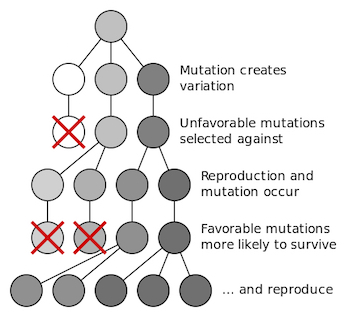
Medical science and public health measures have enabled the developed world to escape most natural selection, for the most part, certainly for the past several decades. Most human babies now survive to adulthood in developed countries. Survival is constantly improving and that's very different than things were throughout the history of life on Earth. In Darwin's time, for instance, only about 50 percent of British children survived to age 21, so in those days natural selection was certainly operating on humans.
Due to the marginalization of natural selection, futurists often predict that humans will not evolve more in any major way. These include high-profile science figures such as Sir David Attenborough, and even some biologists, such as Professor Steve Jones of University College London, who have said that "evolution is over" for humans, at least in the developed West. Another researcher, Peter Ward, a paleontologist at the University of Washington has written, "I don't think we are going to see any changes - apart from ones we deliberately introduce ourselves, when we start to bio-engineer people, by introducing genes into their bodies, so they live longer or are stronger and healthier."
This idea certainly would be true, were natural selection inserted in place of evolution. Natural selection won't provide us bigger brains, webbed hands or feet, or improvements in vision or hearing. This is because people who are exceptionally intelligent, have slight webbing in their hands, or have impressive hearing or vision ability end up having the same chance of having children as anyone else. Nearly everyone lives to reproductive age and the decision to have children or not is largely independent of physical health or prowess, and that's why natural selective forces no longer operate on most of the human population.
But predicting future events entails a great deal of uncertainty. Though not by natural selection, humans may very well evolve dramatically, and this is where the other evolutionary forces come into play. Certain possibilities of our future evolution can be explored, through the careful and creative framing of testable questions relevant to predictions. Imagined functional human adaptations of body parts, for instance, may have corollaries elsewhere in the animal kingdom that scientists may have studied already. Data from current trends in the human population may be relevant to future developments. We'll consider a handful of directions that human evolution could take.
Natural selection sidelined by medical science?
This first possibility assumes that failure of an individual to reach reproductive age and then actually give rise to offspring is the major evolutionary force. In nature, natural selection is the most powerful evolutionary force, but other factors may take over, in a sense, when technology grants a second chance to those who would have died in the wild. Consequently, even a complete lack of natural selection doesn't mean that humans will not evolve.
In his groundbreaking book On the Origin of Species, Charles Darwin proposed natural selection as the mechanism by which evolution operates. Natural selection is often explained as 'survival of the fittest'. Those individuals that are born with traits that best enhance survival to maturity are more likely to grow up and reproduce compared with individuals lacking such traits. (See our module Charles Darwin II: Natural Selection for more information.) Another way of saying this is: fitter individuals out-compete those that are less fit to survive in a particular environment. When an individual leaves offspring, its traits are passed down in genes to a new generation.
Darwin did not know about genes, but careful, detailed observations during his famous voyage on the Beagle led him to make observations of phenomena that were consistent with the idea that traits somehow were transferred from generation to generation. One observation that Darwin made was that in each generation more offspring were born than could possibly survive. In nature, many that are born to parents simply do not survive to maturity, but this was also a reality for humanity until very recently. Consider families living right here in North America around the turn of the 20th century. Particularly in urban areas, such as New York City, where immigrants were arriving in droves. Couples had many children intentionally, expecting that some would die of diphtheria, measles, polio –any one of a plethora of communicable diseases. This was a typical way that people used to die, but did their deaths lead the survivors to evolve some resistance to these diseases through natural selection? It's hard to know because within a generation or two there were vaccines for all of these diseases, so the population was immunized artificially.
A similar phenomenon emerges if we consider purification of public water supplies and antibiotics, drugs that kill bacteria. Most of the medical conditions that used to kill high numbers of babies, children, teens, and young adults as recently as a century ago are either prevented or cured today. Furthermore, children who are born with major disabilities, such as missing limbs, can today grow to adulthood and reproduce in a world where technology for prosthetic limbs is developing rapidly.
Can one measure a lack of evolution? That is hard to do over the span of the few generations during which modern science has been operating, but it may be possible in the future. One strategy might be to monitor changes in sequences of human genes vital to immunity and disease, intelligence, athletic fitness, and other traits, then compare the rates of change with similar genes in species that live in the wild.
In the sections below, we'll examine phenomena apart from natural selection that may facilitate further human evolution. But first it's important to note that even natural selection may not be "over for humans." The reason has to do with disease – a selective force that clearly has shaped human evolution in recent centuries and may still be doing so today. Two notable examples are the human immunodeficiency virus (HIV) and the malaria parasite.
The HIV/AIDS epidemic broke out globally in the early 1980s. It was deadly, but survival has increased dramatically in developed countries, since the early 2000s (Figure 2). Due to combined therapy consisting of several different drugs, each of which attacks the virus in a different way, a human found to be HIV-positive can live for decades. Treatment is extremely expensive, however, and for millions of people infected in parts of Africa and Asia, the prognosis has changed little since the 1980s. They die quickly and will continue to do so for the predictable future.
Figure 2
But not everybody who is exposed to HIV develops AIDS. A fraction of people happen to be resistant and so Darwinian evolution predicts that genetic sequences underlying HIV resistance should increase their frequency. In fact, studies show that this is happening. The frequency of various genetic factors associated with a shortened time between infection and the development of the disease is decreasing. Scientists call these factors frailty alleles - they are gene variants that cause a person to be frail with respect to HIV. This is to say that the virus makes its way through their system relatively fast and so their immunity degrades quickly compared with others, leading to a quick death.
When it comes to malaria, studies of human remains from Neolithic (New Stone Age) burial sites in the Middle East have uncovered molecular evidence supporting the idea that malaria first entered human populations only about 8,000 years ago. There are people who are heterozygous for certain genetic diseases of hemoglobin, the compound that carries oxygen in the blood, meaning that they have both the normal and abnormal genes. These people are able to resist malaria. The first such example to be recognized was the sickle cell gene, which causes serious disease in those with two copies, but persists because it protects heterozygotes against malaria. But the archeological studies show that the sickle cell gene was only part of the malaria response, as malaria also drove various dietary and cultural developments that helped to mitigate the malaria risk.
Today, scientists are trying to develop vaccines both for HIV and malaria. There is some progress, particularly with respect to a malaria vaccine. But even if a vaccine is ready tomorrow, the history of vaccination shows that eradication can take well over a century. Thus far, smallpox is the only disease that has been eradicated. That happened in the late 20th century, yet smallpox vaccination was invented nearly 200 years earlier. Similarly, the first polio vaccine was developed in the mid 20th century, but only now is eradication on the horizon.
Medical technology will continue to advance and humans will conquer HIV, malaria, and a host of other infectious diseases. Once that happens, natural selection related to those infections could stop, but there will be other diseases. There could be a worldwide supervirus, or medical research could start losing the on-going battle to keep developing new antibiotics to stay ahead of antibiotic-resistant bacteria. This could lead to a resurgence of natural selection as an evolutionary force.
Taking an optimistic view of medical advancement, however, let's imagine a future in which humans can avoid plagues and continue to increase the lifespans. In such a case, we're really talking only about the other evolutionary forces. We'll examine those in the context of the other possible human evolutionary scenarios, but first let's consider one more phenomenon related to natural selection: mate selection.
When it comes to choosing mates (as opposed to simply living long enough to mate), the consequence is not life or death, but selection is still operating. The classic example in the animal kingdom is the male peacock, a bird that attracts a mate with a beautiful, colorful plume (Figure 3). Those that are less fit - males that lack a colorful plume - may not pass on their genes, so natural selection is widely in play even if an unmated peacock lives to a ripe old age.
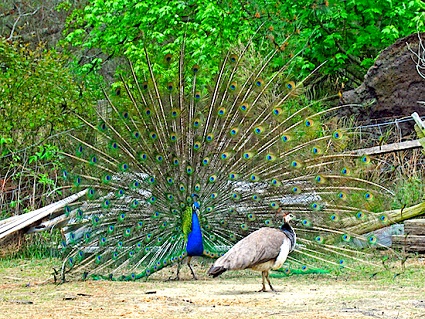
Do factors like hairstyles, makeup, clothing, and development of an attractive physique through exercise produce a similar effect in people? University of New Mexico evolutionary psychologist Geoffrey Miller thinks that sexual selection may currently be a major factor in human evolution. Mastering increasing technology requires increasing intelligence, so intelligence leads both to economic and social success, including mating. To be sure, mate selection for a relationship such as marriage does not equal reproduction, as people can reproduce with mates they choose on a whim for a brief encounter. Applied statistically to a population, however, the factors that Miller has considered may produce a noticeable effect on the gene pool. If the effect actually occurs then it would be an example of natural selection shaping the human gene pool
Comprehension Checkpoint
Which is the better example of natural selection at work?
Artificial selection
The term artificial selection implies a process affecting evolution the same way as natural selection, but due to human activity as opposed to natural processes. An example is the evolution of dogs from wolves; this happened over many millennia, beginning in the Stone Age. Humans would tolerate a companion wolf that happened to be non-threatening, but not one that was aggressive. Being more friendly to humans thus became a survival advantage, so gradually dogs branched off from wolves. Stone Age humans weren't creating dogs consciously, at least not at first, but once they had a population of docile wolves, their value as look-outs, vermin hunters, and shepherds was exploited and the population was shaped further. In more recent centuries, humans have purposely bred dogs into numerous varieties for specific jobs or purely for personal enjoyment. Humans have similarly domesticated many other animals including horses, cows, goats, sheep, llamas, and so on. This, along with many plant species, marked the invention of agriculture and brought humanity into the modern era. Modification of organisms for food continues to this day.
The attempt to use artificial selection to breed traits into and out of humans is called "eugenics" and represents one of science's greatest shames. It was a popular goal at the turn of the 20th century when eugenicists proposed eliminating "undesirable" genes by selective sterilization of what they considered to be "inferior" ethnic and economic groups. Acceptance of eugenics as a legitimate scientific endeavor was widespread in the West until the end of World War II, when the natural extension of eugenics – the Nazi holocaust – was fully revealed to the world at the Nuremberg trials. Today, eugenics of humans is universally denounced as immoral, but what about artificial selection happening as an unintended consequence of something else?
Research suggests that such artificial selection is happening at least in the context of two common procedures in obstetrics and gynecology: cesarean section and abortion.
Cesarean section, or surgical birth, is where a fetus is delivered through surgical incisions made through the abdominal wall and through the uterus. This is in contrast to vaginal birth that evolved in nature where the infant comes out through the birth canal. From the time that the human brain started to increase dramatically in size in early hominids until the early 20th century (Figure 4), the constraints of vaginal birth put limits on how big a fetal head could grow and how narrow a female pelvis could be. Either a fetal head too big or a maternal pelvis too narrow would mean that one or both individuals would die and the genes responsible for those traits would die with them.
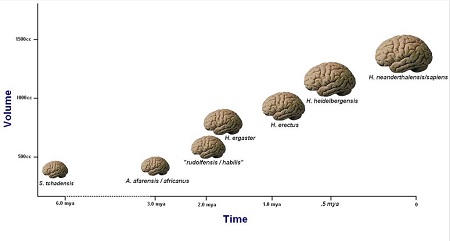
Cephalopelvic disproportion (CPD) is what doctors call the condition when the fetal head is too big compared with the size of the mother's pelvis. The chances of developing CPD depend greatly on the mother's genetic tendency to develop a narrow pelvis. 200 years ago, if a pregnancy was in a state of CPD, the woman and fetus would die, since the head could not get through the birth canal. Remembering that all organisms experience random mutations and spontaneous diversity in all traits, occasionally a genetic tendency toward CPD will develop. Tragically, these random mutations will not persist because they end up being lethal, either to a mother or to her potential offspring.
Around 1900, however, surgeons were perfecting their ability to bypass the birth canal altogether. This involved accessing the uterus through the abdomen, delivering the child, and repairing the wounds without the mother bleeding to death in the process. The result is that the CPD condition would not have to be fatal. In the developed world, surgical birth has been increasing dramatically since the 1960s. Today, some countries have a cesarean rate as high as 40 percent. In a sense, the invention of surgical birth has removed the intense selective pressure constraining the size of both the fetal cranium and the female pelvis. It is likely that, humans being the diversity-generation machines that we are, larger fetal heads and smaller female pelvises could arise via spontaneous mutations.
But has the removal of selective pressure of the birth canal actually enabled changes in the size of the cranium and hips? For the past several decades, physicians have been monitoring head circumference from birth through early childhood, because it is very much related to developmental problems. Both microcephaly (small head circumference) and macrocephaly (very large head circumference) are connected with a variety of physical and mental abnormalities. Based on these observations, there is no evidence of an increase in head or brain size in medically normal humans in the era of surgical birth. On the other hand, the increase in surgical births since the 1960s has been correlated with an increase in narrow hips in females, so we can anticipate more women with narrow hips in the decades to come. This really means increasing genetic disposition for narrow hips in the human gene pool.
The flip side to cesarean section is elective abortion. Combined with genetic counseling, intentional termination of pregnancy appears to be producing a noticeable decrease in the number of children born in Middle Eastern countries with a genetic blood disorder called thalassemia. Screening and counseling are intended to discourage marriages between thalassemia carriers – individuals with a genetic makeup that's part normal and part thalassemia. These individuals may or may not have mild symptoms of the disease. In practice, however, few marriages are discouraged; instead, parents tend to opt for abortion when prenatal screening shows that fetus would suffer from severe thalassemia, or in many cases thalassemia of intermediate severity. As a result, the frequency of thalassemia genes is on the decline in certain Middle Eastern countries. This is happening despite the fact that thalassemia carriers resist malaria, just like carriers of the sickle cell gene. This means that genetic counseling and abortion are affecting thalassemia genes more than malaria is affecting those genes. Most likely, this is because malaria has been on the decline for the past few decades in certain Middle Eastern countries, Turkey for instance.
Comprehension Checkpoint
A rise in the number of surgical births is linked to an increase in _____.
Future evolution and space exploration
Along with natural selection and mutation, genetic drift can also influence evolution and can be caused by founder effects or bottlenecking. A founder effect (Figure 5) happens when a small group of individuals breaks off from a larger population in order to relocate (like the founders of a colony). Bottlenecking (Figure 6) is when most of a large population is destroyed, leaving a much smaller group to repopulate the species (analogous to how the neck of a bottle allows only a small sampling of contents to get out). Both of these are evolution events, because the relocating or surviving individuals carry just part of the original gene pool (the collection of genes in a population) and the frequency of gene variants, or alleles, is different from that of the larger population from which the smaller has broken off (see our module Population Genetics: An Introduction for more information). Genetic drift is a change in frequencies of genes and alleles over time, due to random sampling error. It happens significantly in small populations, which is why it is particularly likely following a bottleneck or a founder event.
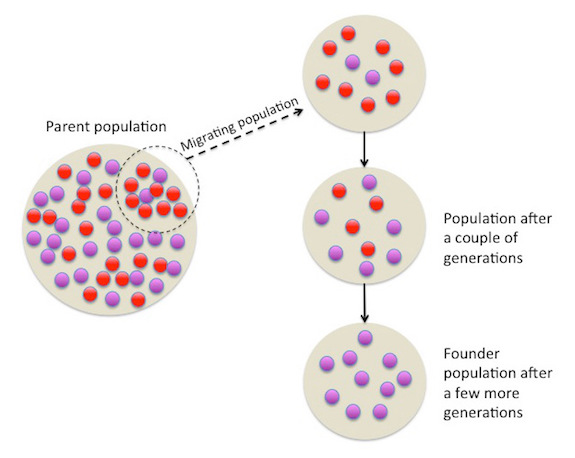
The Maori people of New Zealand were isolated from the rest of modern humanity for something like 50,000 years. However, when Dutch and British explorers reached Australia in the 17th century, the natives that they found were members of the same species as all other modern humans, Homo sapiens. This means that while they had distinguishing physical traits, Australian Aborigines could mate with other humans and produce fertile offspring. These were different populations, not different species.
Today, people from different continents marry and have children at ever-increasing rates. There is no place on Earth where humans can be as isolated as much as Australian and New Zealand natives were prior to the arrival of Europeans. But what about in an extraterrestrial colony? There is serious discussion about founding a human settlement on Mars, perhaps preceded by a settlement on the Moon. Even if these outposts were to grow into fully independent colonies with their own governments and resources, such societies would not be genetically isolated. New colonists would be arriving from Earth for centuries to avail themselves of opportunities and to expand colonial populations, plus colonists would also travel back to Earth. The same would happen with human settlements in the atmosphere of Venus, on Moons of outer planets like Saturn, or in "free space" colonies, settlements flying on their own around the Sun or any planet. In genetic terms, there would be plenty of gene flow in both directions, keeping the colonial group unified with the parental population.
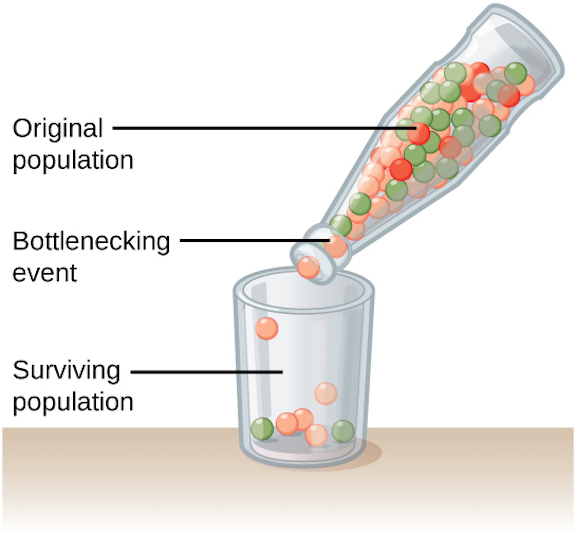
Colonies at a greater distance are another story. Someday, humans may board starships on flights that span generations or we may send cryopreserved humans to cross the enormous distances between stars. Depending on travel times and technological limits, it's plausible that interstellar colonization would mean that the human colonies are physically isolated, not for hundreds of years, but for thousands or even hundreds of thousands of years. In such cases, even small contributions from natural selection on the isolated population could have a noticeable effect over time because there would be no gene flow to keep the colony connected to the same larger gene pool.
This, together with founder effects, genetic drift, and mutation could reshape the isolated gene pool so much that after a very long time, descendants of the interstellar colony could not mate successfully with their distant cousins remaining in the terrestrial solar system (or with those living in other interstellar human settlements). This reproductive isolation could take a few different forms. On one hand, people on distant colonies after a long isolation might appear and act so differently that they won't be attracted to earthlings or vice versa and thus won't mate. This is called behavioral reproductive isolation and it's not enough to make the two groups separate species entirely, but rather different subspecies.
Should descendants of human interstellar colonists and those remaining on Earth become firmly reproductively isolated, speciation will have occurred (Figure 7). This would take many millennia of separation, letting nature run its course, but it might also happen faster if humans on those new worlds made it happen intentionally. They might do so to adapt themselves to the environments of their new worlds. On the other hand, humans might choose to manipulate evolution, even for those who remain right here on Earth.
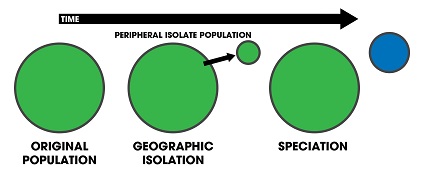
Comprehension Checkpoint
"Zorses" and "zonkeys" are sterile because _____.
Transhumanism: shaping our evolution through technology
Transhumanism is the idea that humans can evolve new physical and mental capabilities, particularly through the use of science and engineering. In a literal sense, all of us are transhumans already, because we've extended our natural capabilities with technology. This began with simple inventions like clothing in Stone Age times, but you can extend that to people today walking around with artificial valves and pacemakers in their hearts and implanted pumps that infuse them with drugs, such as insulin. The concept can be extended to include communication equipment that we wear, such as smartphones, or vehicles that we enter, such as cars and aircraft. Biotechnology is developing at an ever-increasing rate. Bionic limbs are being tested, arms and legs that a wearer can control via thoughts from his or her brain. Biomedical devices are becoming more dependent on computing capability, improvement of which has followed the so-called Moore's Law, proposed by the founder of Intel Corporation, who suggested that computing power doubles roughly every 18-24 months.
There may be a theoretical limit to computing power, but it is at least a few decades before we reach it. Along with sheer computing power, developments such as nanotechnology, new genetic engineering methods, and integration of biological and electronic technology will add to what is possible. Thus, at some point in the decades to come, we can expect various technologies that today seem like science fiction, such as a bionic artificial heart that can replace a diseased heart and run indefinitely. Or maybe we will develop the ability to grow a genetically-matched human heart in a host animal such as a pig or sheep.
Even if bionic parts and the digitization of the human mind may one day turn humans into cyborgs, this would still not represent biological evolution in the strict sense, since that refers only to genetic changes. Even gene therapy, in which diseased cells in a patient's body can receive new genetic instructions, occurs without alteration to the heritable genome inside the gametes (sperm and eggs).
One day the human genome could be altered in a heritable way with a DNA editing system called CRISPR. Scientists are already editing genomes of other organisms using CRISPR technology. Researchers in the US and the UK have created experimental male mosquitos of the species that carries the malaria parasite. The engineered genome of these mosquitos is able to deliver what's called a gene drive (Figure 8), which can spread a trait to other mosquitos of the same species, such as the ability to make antibodies against the malaria parasite. What the CRISPR coding does is copy the anti-malaria gene from one chromosome to the other matching chromosome. As a result, nearly 100 percent of an engineered mosquito's offspring will have the antimalarial gene, rather than the 50 percent that we would expect with Mendelian genetics. In this way, in the course of a single season, nearly the entire population of a species in a region, the Brazilian rain forest for instance, can be altered to carry the new gene. If we can do this with insects, similar things could also be done with humans, in which case we're talking about genetic changes passed through gametes to new generations, and thus true biological evolution. Why might we go down such a path?
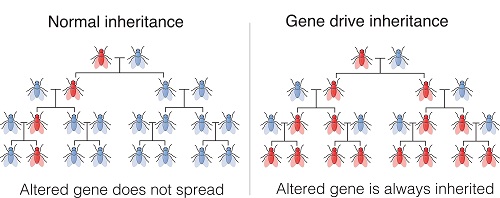
One reason might be to adapt to the environment of another planet, such as Mars or Venus, but humans surely might want to change themselves on Earth too. Humans might want stronger immune systems, stronger muscles, better vision and hearing, better brains, or even bodies that age more slowly.
Any or all of these technological developments could replace natural selection as the major force in human evolution. Therefore, the claim that "evolution is over" for humanity seems very unlikely. After all, the only constant in the universe is change.
Summary
Some noted modern scientists have declared that human evolution is over. With advances in medicine and public health, natural selection is no longer a major shaping force for humans. Even so, it doesn't mean that humans won't evolve. This module explores the various directions that human evolution might take. Various influences on human evolution are discussed by way of specific examples, including artificial selection through surgical advances and how "bottlenecking" could affect the human gene pool if distant space colonies are formed in the future.
Key Concepts
- Humans continue to evolve due to a variety of evolutionary forces: natural selection, artificial selection, genetic drift, and via transhuman breakthroughs.
- Evolution is the gradual genetic change of a species over time due to unequal reproduction among members.
- Natural selection is the phenomenon that rewards certain advantageous traits and punishes others through better or worse survival or reproduction. Natural selection is one of the forces that moves evolution forward.
- Artificial selection is the selective breeding of animals or plants by humans to modify an organism.
- Genetic drift is a change in the frequency of a population's genes and alleles over time, often by founder effects (when a small group of individuals relocate) or bottlenecking (when a large population is decimated, leaving a smaller group to repopulate).
- Transhumanism is the idea that humans can evolve new physical and mental capabilities, particularly through the use of science and engineering.
Source: https://www.visionlearning.com/en/library/Biology/2/Future-of-Human-Evolution/259
Belum ada Komentar untuk "Which of the Following is Not an Indication That Humans Are Continuing to Evolve"
Posting Komentar